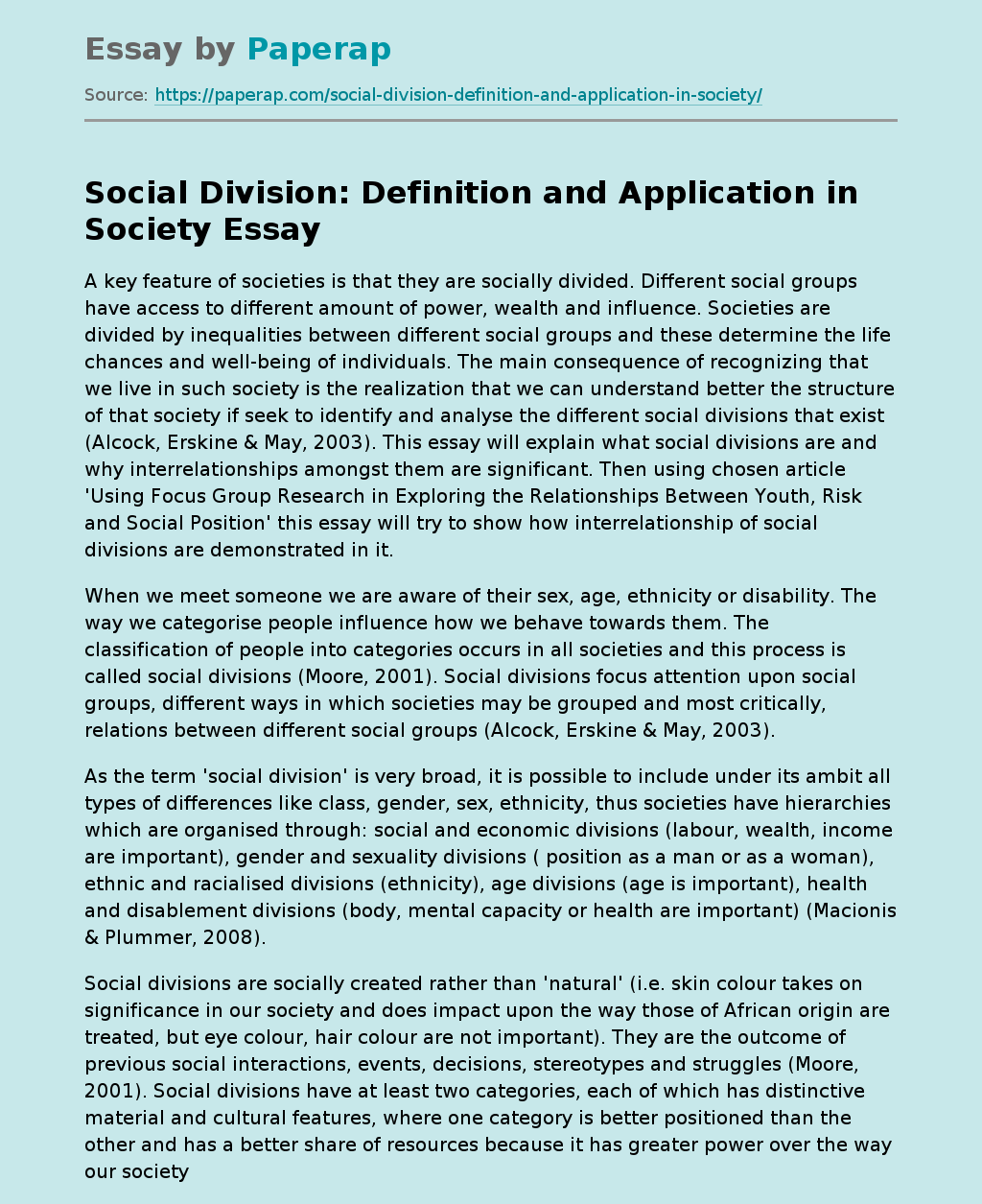Social Division: Definition and Application in Society
A key feature of societies is that they are socially divided. Different social groups have access to different amount of power, wealth and influence. Societies are divided by inequalities between different social groups and these determine the life chances and well-being of individuals. The main consequence of recognizing that we live in such society is the realization that we can understand better the structure of that society if seek to identify and analyse the different social divisions that exist (Alcock, Erskine & May, 2003).
This essay will explain what social divisions are and why interrelationships amongst them are significant. Then using chosen article ‘Using Focus Group Research in Exploring the Relationships Between Youth, Risk and Social Position’ this essay will try to show how interrelationship of social divisions are demonstrated in it.
When we meet someone we are aware of their sex, age, ethnicity or disability. The way we categorise people influence how we behave towards them. The classification of people into categories occurs in all societies and this process is called social divisions (Moore, 2001).
Social divisions focus attention upon social groups, different ways in which societies may be grouped and most critically, relations between different social groups (Alcock, Erskine & May, 2003).
As the term ‘social division’ is very broad, it is possible to include under its ambit all types of differences like class, gender, sex, ethnicity, thus societies have hierarchies which are organised through: social and economic divisions (labour, wealth, income are important), gender and sexuality divisions ( position as a man or as a woman), ethnic and racialised divisions (ethnicity), age divisions (age is important), health and disablement divisions (body, mental capacity or health are important) (Macionis & Plummer, 2008).
Social divisions are socially created rather than ‘natural’ (i.e. skin colour takes on significance in our society and does impact upon the way those of African origin are treated, but eye colour, hair colour are not important). They are the outcome of previous social interactions, events, decisions, stereotypes and struggles (Moore, 2001). Social divisions have at least two categories, each of which has distinctive material and cultural features, where one category is better positioned than the other and has a better share of resources because it has greater power over the way our society is organised. In other words divisions tend to divide people into ‘better’ or ‘worse’ categories creating social inequalities. Those in the ‘better’ categories have more control over their lives, more money and can generally be seen to lead happier lives.
Those occupying the better positions often take their advantages for granted but, nonetheless, social divisions are still all about advantage and disadvantage. They are therefore also about who has the power to create and maintain this situation in which inequalities persist (Payne, 2006). The particular combination and balance of memberships also matter. For example, to be white, middle class, male and healthy is not only different from being black, working class, female and sick, but also different from being black, middle class, male and healthy. We need to consider how the various divisions seem able to work in specific combinations and, in a somewhat less coherent way, also work together as a whole to make up what we know as ‘society’ (Payne, 2006).
Moreover divisions require at least two sides – for example, to be black or white, male or female, in good health or ill, heterosexual or homosexual and this often implies a hierarchical relationship in which one category is advantaged precisely because it is more highly valued in relation to its opposite, at a structural, social level. Since the two sides are constructed in relation to each other to belong to one side is defined in terms of not belonging to the other. In this sense the two sides of social divisions can be seen as mutually constitutive: one side exists only in relation to its opposite and is defined by its difference from this opposite (Braham & Janes 2002).
However social divisions are neither permanent nor fixed but they are ‘socially constructed’, so that while there are always social divisions, their precise form varies from society to society. For example seeing men and women as groups posits a form of classification of individuals according to certain criteria usually dependent on genitalia but also behavioural, identificational and performative criteria, but this does not mean that these individuals always belong together, i.e. to the same group, for they can be allocated or allocate themselves to others on other criteria (Anthias, 2001).
Social Division: Definition and Application in Society. (2017, Dec 22). Retrieved from https://paperap.com/social-division-definition-and-application-in-society/

